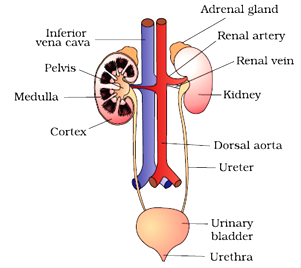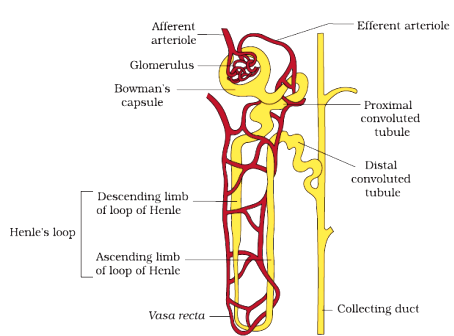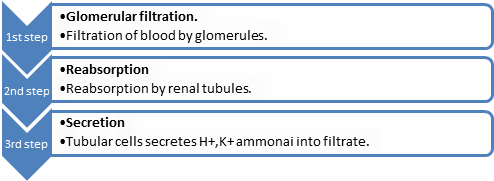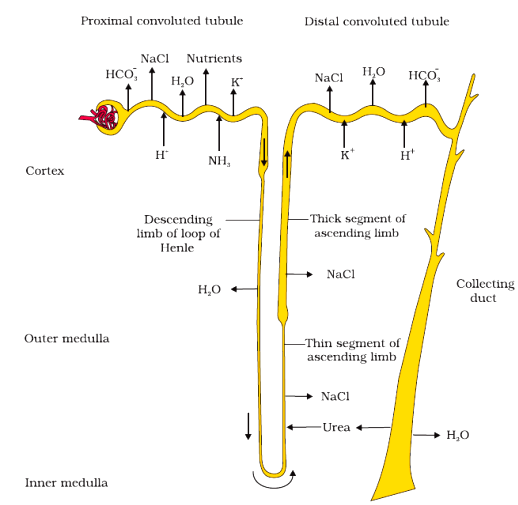Excretory Products - Revision Notes
CBSE Quick Revision Notes
CBSE Class-11 Biology
CHAPTER-19
EXCRETORY PRODUCTS AND THEIR ELIMINATION
- Elimination of metabolic waste products from the animal body to regulate the composition of body fluids and tissues is called excretion. These waste products include ammonia, uric acid, urea, carbon dioxide and ions like , , Cl- and phosphates and sulphate.
- Ammonia is the most toxic and uric acid is the least toxic. The process of removing ammonia is called ammonotelism and organisms that excrete ammonia are called ammonotelic (bony fishes, aquatic amphibians and insects).
- The organism that release urea as nitrogenous wastes are called ureotelic (mammals, terrestrial amphibians). The organism that excretes uric acids is called uricotelic (reptiles, birds and land snails).
Animals | Excretory organs |
Flat worms, some annelids and cephalochordates. | Protonephridia or flame cells. |
Earthworms and annelids | Nephridia |
Insects including cockroaches | Malpighian tubules |
Mammals | Kidney |
Human Excretory System
Human excretory system consists of:
- A pair of kidneys
- A pair of ureters
- A urinary bladder
- A urethra

- Kidneys are reddish brown bean shaped structure situated between last thoracic and lumber vertebra. Each kidney has a notch on its inner side called hilum through which ureter, blood vessels and nerves enter.

- Inside the hilum has broad funnel shaped space called renal pelvis with projection called calyces.
- Inside the kidney are two zone- outer cortex and inner medulla. Medulla is divided into medullary pyramids projecting into calyx.
- Cortex extends between medullary pyramids as renal column called Columns of Bertini.
- The functional unit of kidney is nephron. Each kidney contains about one million nephrons.
- Each nephron has two parts- the glomerulus and renal tubules. Glomerulus is the tuft of capillaries formed by afferent arteriole. Blood from glomerulus is carried away by efferent arteriole.
- Renal tubules starts with Bowman’s capsule continue with tubular parts divided into Proximal Convoluted tubules, Henle’s loop and Distal Convoluted tubule.

- The malpighian tubules, PCT and DCT of nephron are situated in cortical region where as loops of Henle’s into medulla.
Juxta medullary Nephrons | Cortical Nephrons |
a. Loop of Henle’s is short and extend only a little into medulla. | a. Loop of Henle’s are very long and extend deep into medulla. |
b. The glomeruli lie close to the inner margin of the cortex. | b. The glomeruli lie in the outer cortex. |
Urine formation

- Glomerular capillaries blood pressure cause filtration of blood through 3 layers (endothelium of glomerular blood vessels, epithelium of Bowman’s capsule and basement layer between two membranes as ultra-filtration.
- The amount of filtrate formed by kidneys per minute is called glomerular filtration rate (GFR) which is 125 ml/minute.
- Glomerular Filtration rate is controlled by Juxta glomerular apparatus (JGA).
- 99% of filtrate has to be reabsorbed by renal tubules called reabsorption.
Function of Tubules
- Proximal Convoluted Tubules (PCT) - all the important nutrients, 70-80% electrolytes and water are reabsorbed.
- Henle’s Loop- maintains high osmolarity of medullary interstitial fluid.
- Distal Convoluted Tubules (DCT) – conditional reabsorption of Na+ and water. Maintains pH and sodium- potassium balance.
- Collecting Duct- large amount of water is reabsorbed to produce concentrated urine.
Mechanism of concentration of urine- The flow of filtrate in two limbs of Henle’s loop is in opposite direction to form counter current. The flow of blood in two limbs of vasa recta increase the osmolarity towards the inner medullary interstitium in the inner medulla.

- The transport of substance facilitated by special arrangement of Henle’s loop and vasa recta is called counter current mechanism.
Regulation of kidney function-
- Functioning of kidney is monitored by hormonal feedback mechanism of hypothalamus and JGA. Change in blood volume, body fluid and ion concentration activates the osmoreceptors in the body that stimulate the hypothalamus to release ADH or vasopressin hormones. The ADH facilitates water absorption in tubules.
- Decrease in glomerular blood pressure activate JG cells to release renin which converts angiotensinogen to angiotensin I and II that increase the glomerular blood pressure and release of aldosterone that increase absorption of Na+ ions and water.
Micturition – The process of expulsion of urine from the urinary bladder is called micturition. The neural mechanism that causes it is called micturition reflex. Urine formed in nephron is stored in urinary bladder till a voluntary signal is given by CNS. This initiates the contraction of smooth muscles of the bladder and simultaneous relaxation of the urethral sphincter causing the release of urine.
- Lungs, liver and skin also play important role in process of excretion. Lungs remove and water, liver eliminates bile containing substances like bilirubin, biliverdin. Sweat glands remove NaCl, small amount of urea and lactic acid. Sebaceous glands excrete sterol, hydrocarbons and waxes.
Disorders of Excretory System
- Uremia- there is high concentration of non-protein nitrogen (urea, uric acid, creatinine). Urea can be removed by hemodialysis.
- Renal failure- also known as kidney failure where glomerular filtration is ceased and both kidney stops working. Kidney transplant is the ultimate method in correction of acute kidney failure.
- Renal Calculi- formation of stone or insoluble mass of crystallized salts formed within the kidney.
- Glomerulonephritis (Bright’s Disease)-inflammation of glomeruli of kidney due to entry of protein or red blood corpuscles in to filtrate due to injury.